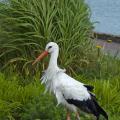Rules of conduct in the biology classroom
1. Arrive to class at least 2-3 minutes before the bell rings.
2. Have replacement shoes.
3. Enter and leave the office calmly, in accordance with the internal rules.
4. Sit in your seat according to the seating pattern established by the class teacher.
5. Moving to another place without the permission of the teacher is strictly prohibited.
6. Prepare your workplace for the lesson, check notebooks, pens, pencils, rulers before the start of the lesson. There should be nothing superfluous in the workplace.
7. While working, maintain silence, be attentive and disciplined in class, and strictly follow the teacher’s instructions.
8. Do not take writing materials from classmates during class and do not distract other students.
9. Do not leave the workplace without the teacher's permission.

10. Maintain order in your workplace.
11. Treat property in the office with care and do not draw on desks.
12. During recess, maintain discipline and order (do not throw objects at each other, do not run around the classroom, do not approach the computer and other equipment, including touching plants and animals, do not play with piercing and cutting instruments).
13. If faults are detected in electrical devices or other classroom equipment, as well as if a fire is detected, safety standards are violated, or students are injured, immediately notify the teacher or administrator on duty.
14. Procedure in case of fire:
Evacuation from the office is carried out according to the school evacuation plan;
Evacuation should be carried out in the following order:
Students in the row by the wall, middle row, row by the window;
Be calm when leaving class
organization and order .

BIOLOGY
- science of living nature.
From Greek words:
βίο, bio – life;
λόγος, logos - teaching, science.


PROPERTIES OF LIVING ORGANISMS
Nutrition
Height
They grow old and die
Breath
Reproduction

Kingdoms of living organisms
Animals
Bacteria
Plants

Animals
Dead remains of plants and animals
Plants
Bacteria and fungi
Salts
Humus

Match the organisms and their characteristics
ORGANISMS
SIGNS
They grow throughout life.
They only grow to a certain size.
Bacteria
They form organic substances from inorganic ones using solar energy.
They feed on ready-made organic matter.
Plants
They inhale oxygen and exhale carbon dioxide.
Cells have a hard cell wall called cellulose.
The main pyment is chlorophyll (green).
Mushrooms
They reproduce by seeds and body parts.
Reproduce by spores
Animals
Reproduce by division

Average cell nucleus diameter
0.5-10 microns.
Anatomy
Virology
A whale's heart beats only 9 times per minute.
About 300 species of amphipods live in Lake Baikal.
Genetics
Ecology
A mule is a descendant of a horse and a donkey.
In the 20th century, the smallpox virus killed 300-500 million people.
Cytology
Like the vast majority of animals, the giraffe has seven cervical vertebrae.
Physiology

Data from which science are presented:
The oldest animal is the reptile hatteria.
Embryology
The oldest tree in the world is pine, which, according to radiocarbon dating, is almost 10 thousand years old.
Bacteriology
Mycology
Chemical reactions occurring in a cell are characterized by high organization: each reaction occurs in a strictly defined place.
Botany
One bacterium can theoretically produce 34 trillion offspring in 24 hours.
Zoology
Elephants carry their cubs for approximately 20-22 months.
Biochemistry
The diameter of the cap of the largest mushroom is 1.3 meters, and its height is 1.5 meters.

10/20/16
History of the development of zoology

History of the development of zoology
I. Accumulation of facts and knowledge about the animal world.
II. Attempts to systematize accumulated knowledge:
1) Works of Aristotle (“History of Animals”, “Ladder of Creatures”)
2) Works of A. Leeuwenhoek (XVII century, made a microscope that made it possible to discover the world of microorganisms)
3) Classification of Carl Linnaeus (XVIII century)

The importance of animals for humans
(in ancient times):
Cloth
Weapon
Food



The most famous today are the drawings in the Nazca and Sahara deserts... The surface of the Peruvian desert with an area of approximately 500 square kilometers is covered with countless ground figures, gigantic in our opinion...
First of all, attention is drawn to the huge images of animals - a monkey, a lizard, a dog, fish and many birds. There is an image of a flower, like a tree.
Animal. The cave paintings in the Cave of Swimmers are from an era when water and animals were abundant in what is now the Sahara Desert.


Scene of a dog meeting a bear. Mount Sakhyurte
Image of a dog and goats on the rock of Mount Sakhyurte.
Hunting scene. Mount Sakhyurte
Rock paintings on the coast of Lake Baikal

Crocodile - sacred animal of ancient Egypt
Sacrifice of the "Bride of the Nile"
Crocodiles in the Nile River
God Sobek
"River Water Manager"

History of the development of zoology
I. Accumulation of facts and knowledge about the animal world
(fossil remains, rock paintings, transfer of experience from generation to generation)

II. Attempts to systematize accumulated knowledge
1) Works of Aristotle (“History of Animals”, “Ladder of Creatures”)
Aristotle (384 BC - 322 BC) - ancient Greek. philosopher and scientist.

2. Works of A. Leeuwenhoek (XVII century, made a microscope that made it possible to discover the world of microorganisms).
Anthony van Leeuwenhoek
Leeuwenhoek microscope

3. Classification of Carl Linnaeus (kingdom, class, order, genus, species).
Carl Linnaeus (1707-1778) - Swedish naturalist who contributed to the creation of the system of nature, described more than 8,000 plant species, introduced binary nomenclature to designate species

Taxonomy of Carl Linnaeus
kingdom(animals)
Class(mammals)
squad(feline)
genus(cat)
view(domestic cat)

Further development of zoology
- Discovery of transitional forms
Archeopteryx is a transitional form between reptiles and birds

An ancient lobe-finned fish from which amphibians evolved
Ichthyosteg is a transitional form of organisms from aquatic to terrestrial lifestyles

The presentation "History of Zoology" can be used when studying new material. Lesson objectives: 1) to give an idea of zoology - the science of animals, the stages of its development, the diversity of the animal world; 2) introduce students to the taxonomy of animals, its main categories, a zoology textbook and educational literature.
Download:
Slide captions:
Aristotle
IV
V.
d
about AD
"Staircase of Creatures"
3
Zoology in ancient and middle ages
Carl Linnaeus
Described 4 thousand species of animals
2
Snowy owl
Genus
View
Zoology in ancient and middle ages
Mikhail Vasilievich Lomonosov
Study of fossil remains
Zoology in ancient and middle ages
Aristotle
IV
V.
d
about AD
"Animal History"
2
Zoology in ancient and middle ages
Carl Linnaeus
1735
Classification of plants and animals
1
What allows scientists from different countries to understand each other?
Little mouse
Genus
View
Introduction.
History of the development of zoology.
Muravleva N.N.
MBOU secondary school No. 2
What allows scientists from different countries to understand each other?
Double names of animals: species + genus
2
Genus
Frog
View
sharp-faced frog
Pointy-faced
frog
Rana
arvalis
Chimpanzee pygmy
Genus
View
Family
Squad
Class
Approach
P
Type
Kingdom
Chimpanzee pygmy
Chimpanzee
Great apes
Primates
Mammals
Vertebrates
Chordata
Animals
Zoology in ancient and middle ages
Aristotle
IV
V.
d
about AD
1
The term "zoology"
Zoology in ancient and middle ages
Anthony
van
Leeuwenhoek
XVII
V.
Our ancestors' ideas about animals
1
Appearance of animals
2
Animal behavior, their habitats
3
Paths of seasonal animal migrations
What allows scientists from different countries to understand each other?
Latin language
1
Pointy-faced
frog
Rana
arvalis
Homework
§ 1.2
With. 7.9
terms
Zoology in ancient and middle ages
The invention of printing
What allows scientists from different countries to understand each other?
Systematic categories
3
Genus
View
Family
Squad
Class
Approach
P
Type
Kingdom
Main systematic category - SPECIES
Our ancestors' ideas about animals
Zoology in ancient and middle ages
Great geographical discoveries
Zoology in ancient and middle ages
Carl Linnaeus
Systematic categories: class, order, genus, species
3
Zoology in ancient and middle ages
Slide captions:
Herpetology
Modern zoology
4 000
9 000
20 000
32 000
6 000
2 600
128 000
28 000
8 000
1 500 000
2 000 000
species
Ornithology
Modern zoology
Entomology
Homework
§ 1.2
With. 7.9
terms
1
2
3
4
Arachnology
1
Consist of cells, breathe, eat, grow, develop, reproduce
2
Have organs and organ systems
3
They feed on ready-made organic matter
4
The cell wall does not contain cellulose and there are no plastids
Page 8
Ichthyology
On the topic: methodological developments, presentations and notes
Work program in biology 6th grade. Authors: Pasechnik V.V., Pakulova V.M., Latyushin V.V., Mash R.D. (51 hours)
The work program in biology for grade 6 is compiled on the basis of an approximate program of basic general education (basic level) in biology; Pasechnik V.V., Pakulova...
Biology work program for the textbook “Bacteria. Mushrooms. Plants” by V.V. Pasechnik, V.V. Latyushin, V.M. Pakulova, 1 hour.
The work program is designed taking into account the reduction of biology hours in grade 6 according to the basic curriculum....
Zoology is the oldest science. Perhaps it is older than all other sciences. Man began to study animals, their way of life, habits, and body structure even before he separated himself from the world of animals and became aware of them as humans. Wherever people settled, they had to thoroughly study the animal world around them: insects, fish, reptiles, birds, mammals. Everyone's life depended on it. Long before the advent of writing, people depicted in rock paintings the animals they hunted (slide 9-12). Rock paintings were also discovered on the territory of Russia - in the Kapova Cave in Bashkortostan (slide 13), as well as in the Chelyabinsk region - in the famous Ignatievskaya Cave (slide 14). The drawings were made in red ocher and belong to an unknown artist of the Ice Age. To understand that a drawing was made on the stone by the hand of an ancient man, the walls of the cave had to be washed from a thick layer of soot that had accumulated here over hundreds of years from torches and fires, kerosene lamps and candles, which were used by everyone who visited the cave. After painstaking work cleaning the walls, archaeologists were presented with images of a mammoth, woolly rhinoceros, horse and bull. In the summer of 2006, archaeological excavations were carried out in our Ashinsky region - in the Kozya cave (slide 15). So far, rock paintings have not been discovered, but many fragments of bones of animals that lived in caves or were brought by ancient people have been discovered (slide 16–18).Thus, people’s knowledge about animals gradually accumulated and, in order not to get confused in this diversity, man made attempts to divide all animals into groups, that is classifications. What stage of development of zoology do you think begins from this moment? (return to lesson plan). Aristotle made the first attempt to systematize animals.
Time passed. The era of great geographical discoveries began, which made it possible to expand knowledge about the species composition of the animal world, and also introduced many legends and fictions about mythical creatures into zoology. With the invention of printing, scientific works began to be published, and, consequently, the circle of people studying zoology expanded. One of these people turned out to be the Dutchman Antonia Van Leeuwenhoek.
Leeuwenhoek's merit lies in the fact that he made a microscope, which made it possible to look at the world of microscopic organisms and begin to study them.
Attempts to describe all known animals and propose their classification have been made repeatedly. The most significant of these was the system of Carl Linnaeus, proposed in 1735. We used his system in 6th grade. Let's remember. (During the conversation, the teacher clarifies the questions: what is a species? By what criteria are plants distributed into genera and families? What do you know about binary nomenclature?) (slide 21)
The contribution of Carl Linnaeus to zoology and botany is invaluable (slide 22).
Thousands of expeditions were sent to all corners of the world to learn on the spot about new animals and their lives. By the beginning of the last century, researchers had studied almost all animals known by that time and collected a great variety of facts. This is what the famous astronomer Shapley said about the mysteries of living nature: (slide 23).
It would seem that everything around us has long been known and does not represent anything interesting. But this is not so, you just have to take a closer look at the familiar to recognize this familiar from a new side. “Live to learn” - this should be the motto of a young zoology lover.
Science zoology Animals have always been of great importance to humans. The life of ancient people depended entirely on knowledge about the surrounding nature, especially about animals. It was important to know where and how to hunt animals and birds, fish, how to escape from predators, and learn how to keep and breed animals.




Aristotle The main work of Aristotle, which determined the further development of zoology, is “The History of Animals.” This work was written in the second half of the 4th century. BC e. in ancient Greek, and was first translated into Russian and published in Russia only in 1996.

Middle Ages The Middle Ages added little to the knowledge of the animal world. Even much information about animals known in ancient times was forgotten. In the Middle Ages, zoological science developed in connection with specific practical tasks: keeping and breeding animals, hunting animals and birds..


Invention of the microscope. From numerous expeditions, travelers brought information about previously unknown animals, and data was accumulated on the distribution and diversity of the animal world. The invention of the microscope was important for the study of protozoa. The art of grinding lenses has been known for a long time.

Antoni van Leeuwenhoek (). We have repeatedly tried to view small objects using several lenses. The greatest success was achieved by the Dutchman Antonie van Leeuwenhoek (). His microscope design was the most successful. We have repeatedly tried to view small objects using several lenses. The greatest success was achieved by the Dutchman Antonie van Leeuwenhoek (). His microscope design was the most successful.

Antoni van Leeuwenhoek (). He discovered and described the world of simplest animals, unknown to scientists at that time. Peter I also came to Leeuwenhoek with the aim of seeing the “secrets of nature.”


Carl Linnaeus The works of the Swedish scientist Carl Linnaeus were of greatest importance for the further development of zoology, which laid the foundation for the modern classification of the animal world and modern scientific names of plants and animals. The works of the Swedish scientist Carl Linnaeus were of greatest importance for the further development of zoology, which laid the foundation for the modern classification of the animal world and modern scientific names of plants and animals

A new stage in the development of zoology Expeditions organized by the Academy of Sciences, created in 1725 on the orders of Peter I, were of great importance for the study of the animal world of Russia. A new stage in the development of zoology, as well as other biological sciences, began in the second half of the 19th century. after the publication of Charles Darwin's book "The Origin of Species by Means of Natural Selection" (1859).









